Athens Bucket List: 15 Unbelievable Things to See and Do
Bright white buildings, sunlit hills, delicious cuisine, and ancient ruins scattered throughout the city all make Athens one of the most incredible cities in Europe.
The capital of Greece is a fascinating blend of the old and the new. You’ll be walking past modern shops and lively cafes one moment, then turn a corner and find yourself staring at a 2,000-year-old temple. The contrast is wild, and just casually strolling by these iconic sites is surreal, to say the least.
Looking out over the rooftops, the city really is white on white on white, stretching all the way to the surrounding hills and mountains. And rising above it all is the Acropolis, perched high on a rocky outcrop in the center of town.
But it’s not just all about the Acropolis — there’s also colorful churches, hilltop viewpoints, impressive museums, and a whole host of othher fascinating historic sites.
This guide covers all the best things to do—the bucket list attractions you simply cannot miss on your trip to Athens.

Plan Your Visit to Athens
- Acropolis + Archeological Sites Combo Ticket: Get timed entry to the Acropolis and entrance to 6 other ancient sites. You can visit these sites anytime within 5 days of your first visit.
- National Archeological Museum Timed Entry Ticket
3 Excellent, Central Hotels in Athens:
- Lekka Hotel & Spa: Beautiful boutique hotel with rooftop bar & Acropolis views
- Hotel Adonis Athens: Great location in Plaka with rooftop terrace Acropolis views
- Emporikon Athens Hotel: Charming boutique hotel with old world charm
15 Bucket List Things To Do in Athens
1. Acropolis
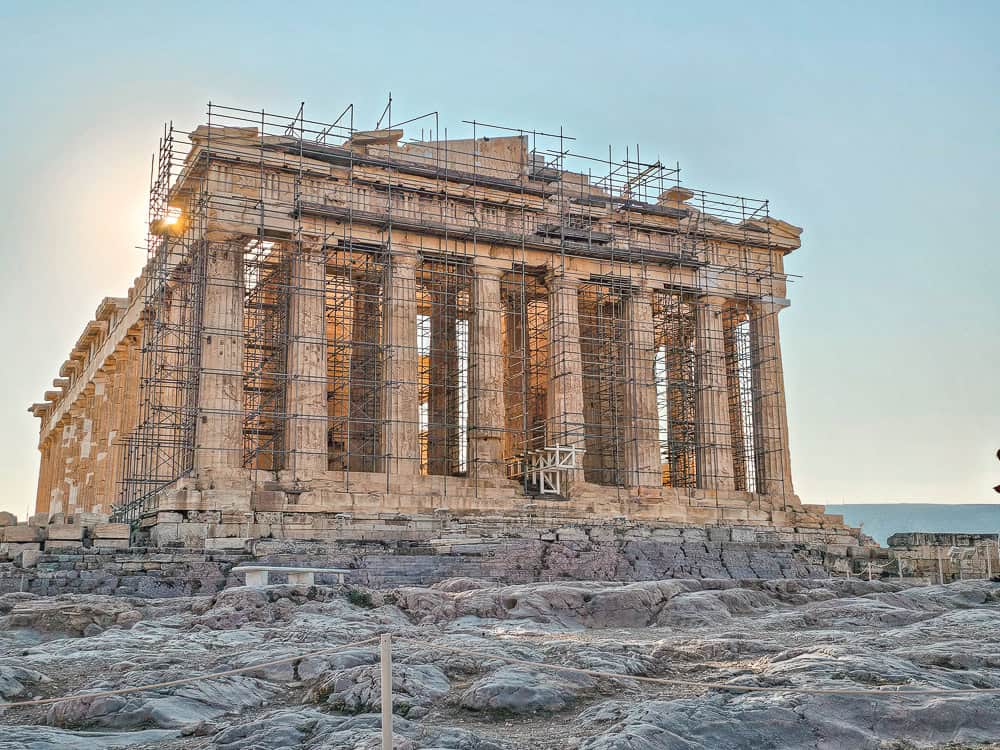
The Acropolis is the shining star of Athens and is truly breathtaking in every way. It sits high above the city on a tall, flat hill (about 500 feet or 150 meters up), right in the middle of Athens.
This ancient citadel is home to several historic temples and buildings, but the star of the show is the Parthenon—a symbol of ancient Greek civilization and one of the most iconic structures in the world.
While all of the buildings are partially ruined, many parts have been carefully restored or are still in decent condition. Just walking through it feels surreal. The scale, the history, the views—it’s every bit as incredible as I was hoping.

Interestingly, even though we tend to picture these buildings as stark white, they were originally painted in bright, vibrant colors—which makes imagining the Acropolis in its prime even cooler.
One of my favorite parts was the Old Temple of Athena, especially the Porch of the Maidens, where statues of women serve as columns. It’s dedicated to Athena, the city’s patron goddess.
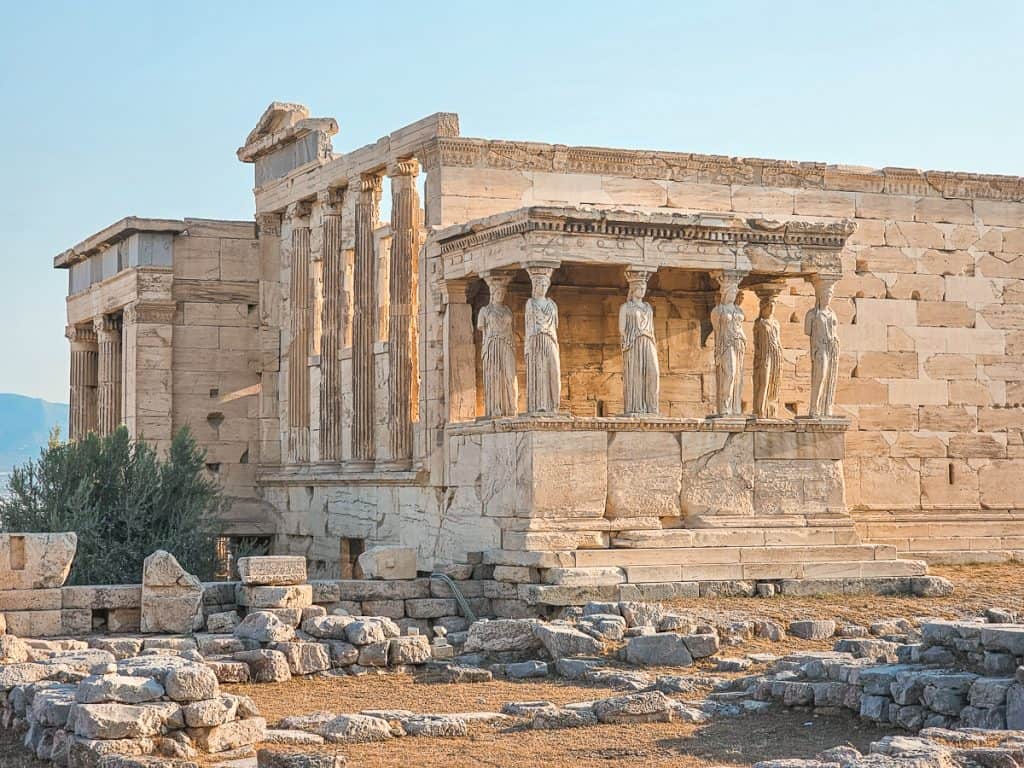
You’ll also pass by the Odeon of Herodes Atticus, a Roman-era stone theater built in AD 161 and restored in the 1950s. It’s a great example of classic Roman theater design and still used today for performances.
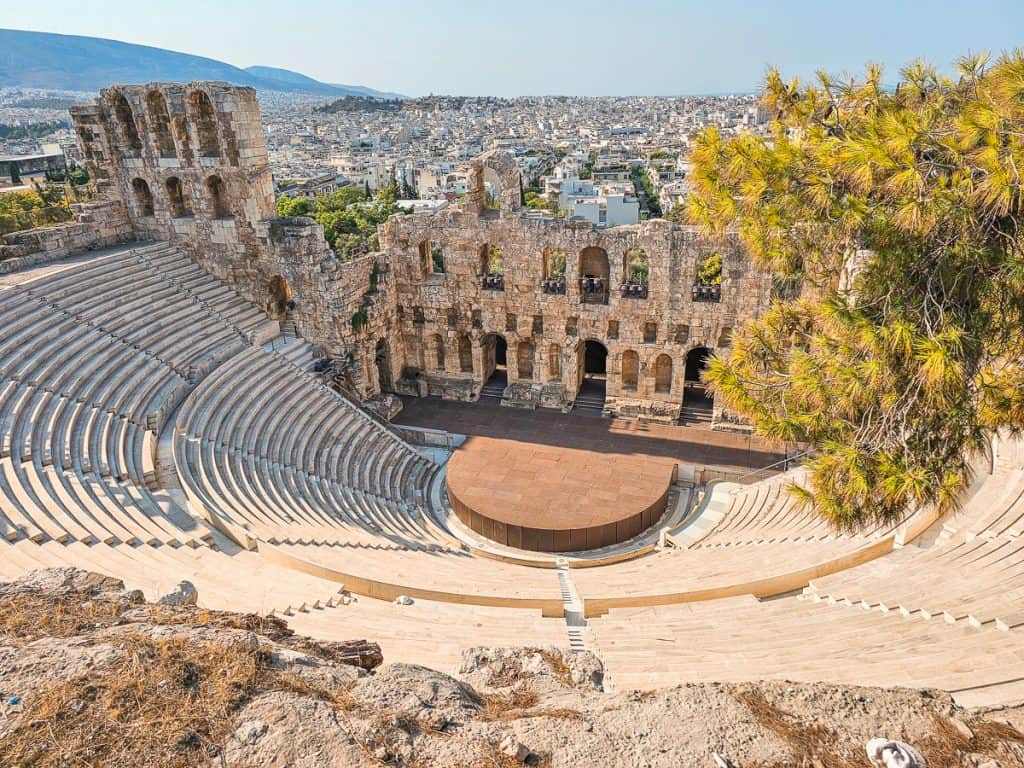
Overall, I loved visiting the Acropolis and think it definitely lives up to the hype. It’s undoubtedly earned its UNESCO World Heritage Site status, and walking through it really feels like stepping into history.
How to Visit & Practical Tips
Tickets: The best value and convenience is the Athens Combo Ticket. This gives you access to the Acropolis and 6 other archeological sites around Athens.
You’ll make a timed entry reservation to enter the Acropolis, but then can visit everything else anytime in the next 5 days. This is hands-down the best way to visit the sites in Athens, so be sure to grab this pass in advance.
When to Go: I’d highly recommend booking the first time slot for the Acropolis (8am), as it gets incredibly busy even by 9:30am. Plan to arrive around 7:40 to have time to get in line.
How Long: Plan for 1-2 hours to explore the site fully.
2. Ancient Agora of Athens
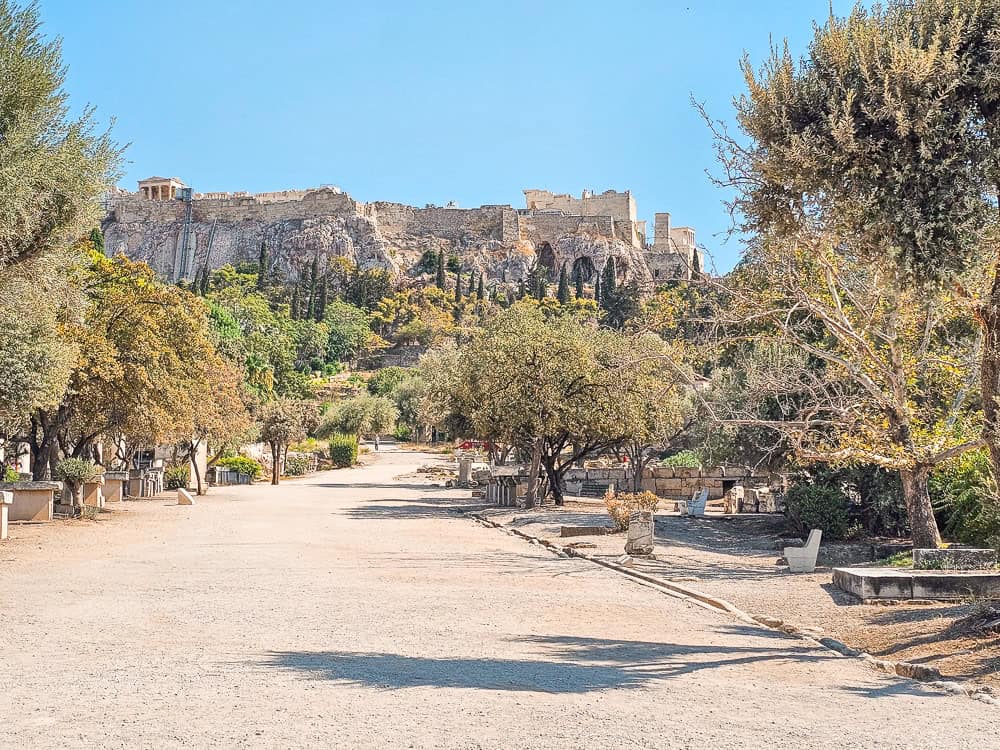
After the Acropolis, the Ancient Agora of Athens is the next must-see archaeological site. It’s a massive, beautifully landscaped space tucked right below the Acropolis, with olive trees, tall cypress trees, and great views of the surrounding ruins and hillside.
The Athenian Agora is often called the birthplace of democracy—this is where the concept first took shape and was practiced in the 5th and 4th centuries BC.

But it wasn’t just a political space. The agora was the center of daily life in ancient Athens, hosting everything from markets and performances to elections, trials, and public debates. Councils met here, laws were passed here, and Socrates, Plato, and Aristotle all spent time here.
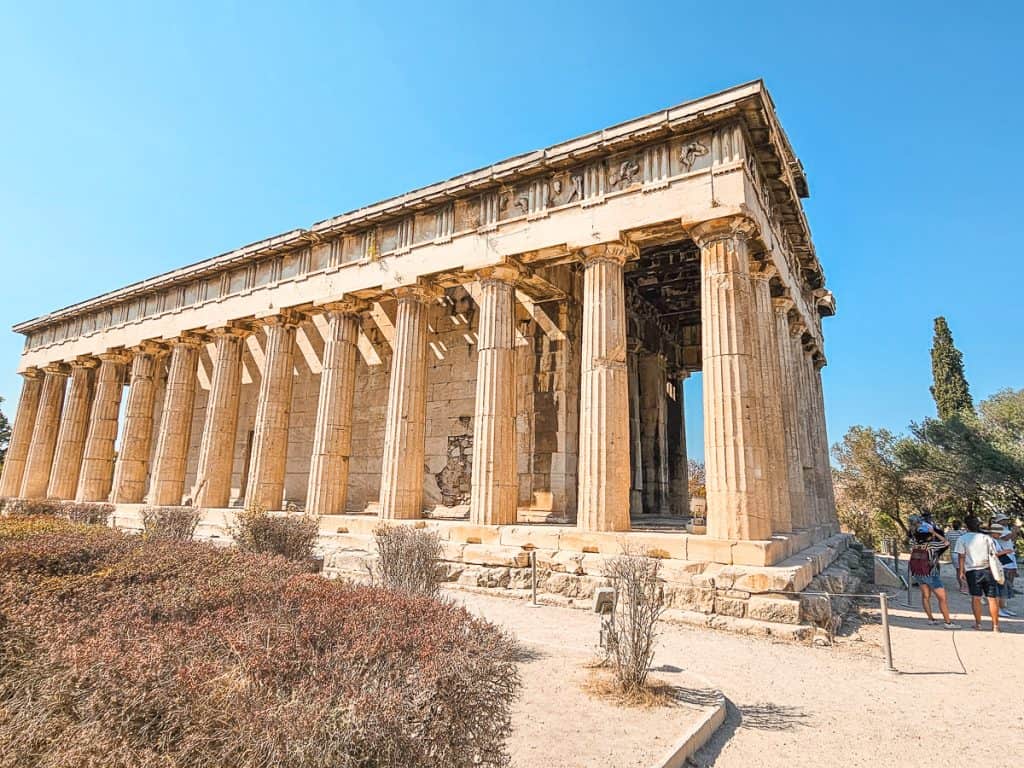
The site today is huge and full of interesting ruins, statues, and pathways to explore. Definitely stop by the Temple of Hephaestus, which is one of the best-preserved ancient temples in all of Greece.
You can also visit the Stoa of Attalos, a long, restored building that now houses a museum with artifacts uncovered from the site.
Tickets: This site is included in the Athens Combo Ticket
3. Hadrian’s Library

Built in AD 132 by Roman Emperor Hadrian, this was once a major cultural hub in Athens. It held over 17,000 books, scrolls, and papyri, and included spaces for reading, lectures, and scholarly discussions. The layout followed a typical Roman forum style—a large open courtyard in the center, surrounded by columns and rooms along the edges.

Today, the ruins are right off Monastiraki Square, and, while the ruins are significant, it’s still a really nice stop. The west wall is the best preserved, with several tall Corinthian columns still standing, along with part of the actual wall.
The library is actually a pretty big site, and wandering through the columns, archways, and ruined walls, you still get a good sense of how massive the original structure was.
Tickets: This site is included in the Athens Combo Ticket
4. Roman Agora
This was the central marketplace when Athens was under Roman rule, built in the 1st century BC with money from Julius Caesar and Augustus. It was a major hub for commercial activity and was actually larger than what’s shown today.

The market was made up of a big open courtyard surrounded by columns and a covered walkway. It’s pretty heavily ruined now, but you’ll still see rows of columns lining the old courtyard, stone steps, and other features.
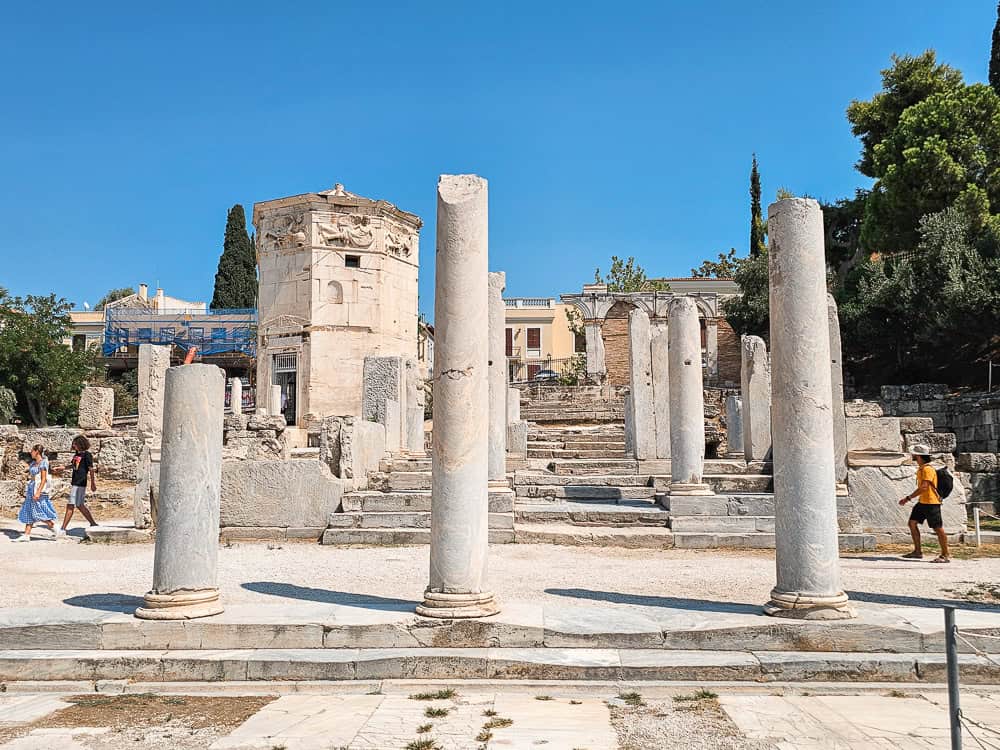
Two of the standout features are the Gate of Athena Archegetis, which served as the grand entrance to the market, and the Tower of the Winds, an octagonal structure in the back corner considered the oldest clock tower in the world.
Tickets: This site is included in the Athens Combo Ticket
5. Temple of Olympian Zeus
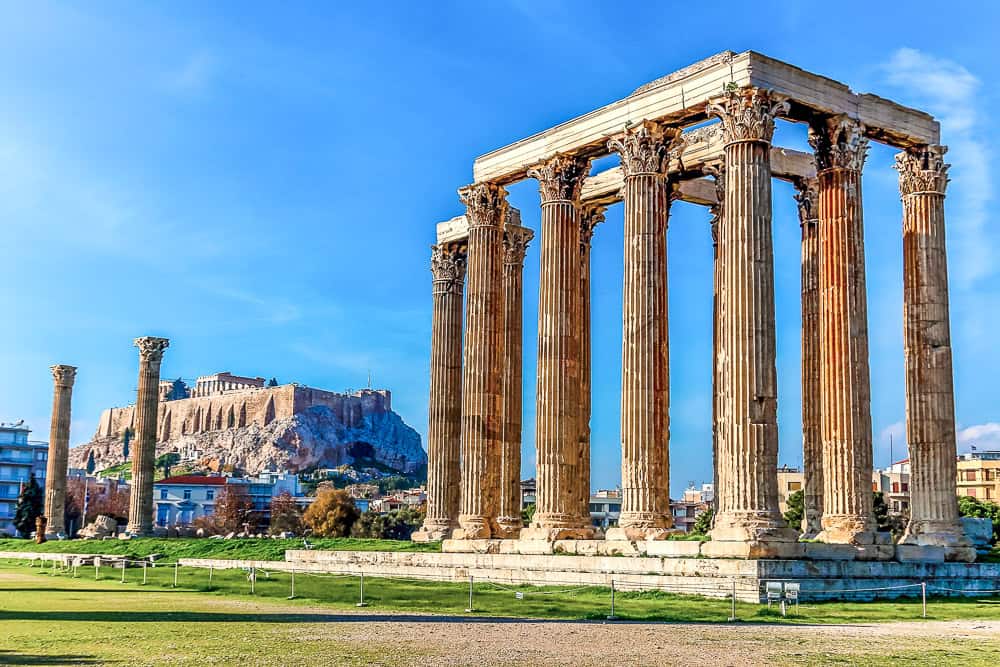
This was one of the most important temples in Athens in antiquity, as it was dedicated to Zeus, the most powerful god. It took nearly 400 years to complete—construction began in 515 BC and wasn’t finished until 131 BC. At its height, it was one of the largest temples in the ancient world, with two rows of 20 columns on the long sides and three rows of 8 columns on the short sides.
Today, a section of a row of columns, plus a few other, single columns are all that’s left standing. Still, what’s left gives you a clear sense of just how massive the temple once was.

Don’t miss Hadrian’s Arch, located just outside the Temple of Zeus. It was built as a grand entrance to the eastern side of the city, marking the transition to the area filled with temples and public buildings.
Tickets: This site is included in the Athens Combo Ticket
6. National Archeological Museum
This is a beautiful museum in a grand building that really fits the vibe of the ancient Greek artifacts inside. When you walk in, you start in rooms filled with jewelry, ceramics, gold plates, weapons, personal items, and other decorative pieces.
From there, you move into room after room of sculptures. It’s a stunning collection, with pieces from all over ancient Greece.
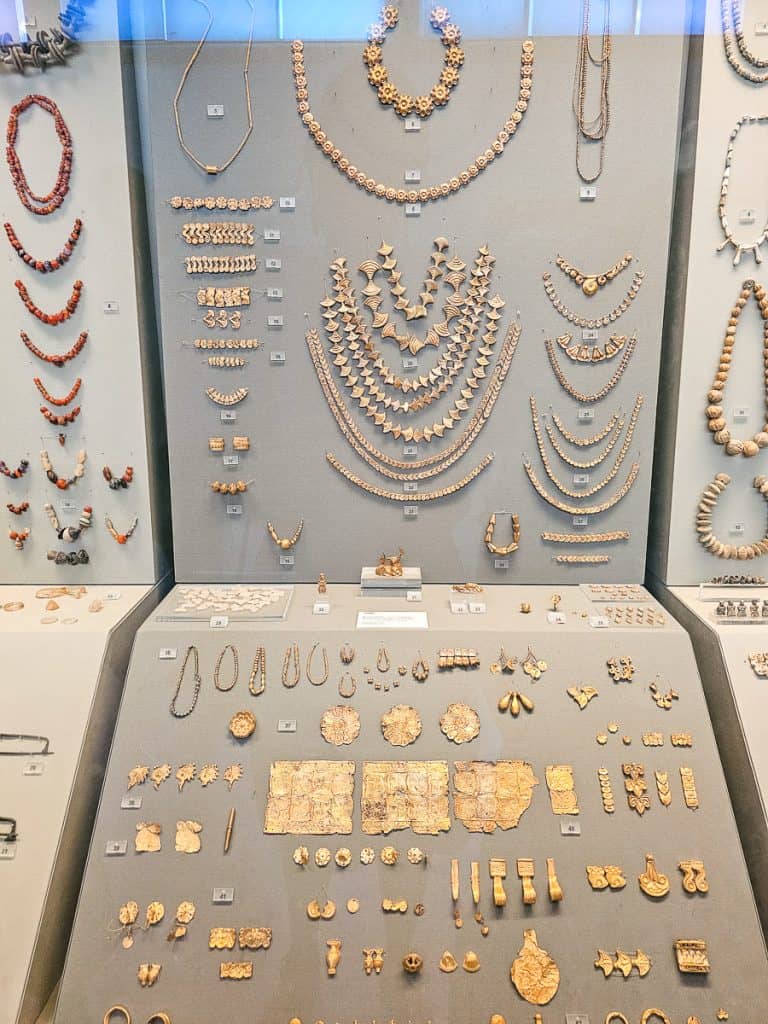
One thing I really liked about the sculpture galleries was how many different kinds of people were represented. In most fine arts museums, the sculptures tend to focus almost entirely on the gods and goddesses.
Here, there were a few mythological figures, but most of the sculptures were of everyday people—plus a few leaders. There were also reliefs and carved panels mixed in with the free-standing works, which made the displays feel more dynamic.

We loved exploring the museum and seeing all the beautiful artifacts on display, and would consider this museum a must-visit. Plan for about 1–2 hours to see everything.
Tickets: Buy your timed-entry tickets online in advance here. If visiting during the summer, I’d recommend visiting the museum in the afternoon to take advantage of the air conditioning.
7. Mount Lycabettus
Mount Lycabettus and Philopappos Hill (which we’ll discuss next) are two very popular panoramic viewpoints in Athens to watch the sunset. While you can indeed see the sunset and the Acropolis from both, they offer vastly different views and experiences.
To start, Mount Lycabettus is on the east side of the city center near the Acropolis. It’s a tall hill, so you can either walk to the top or take a funicular for €12. Plan to wait 5–20 minutes to get on the funicular, especially if you come at sunset.
When you get to the top, you’re on a medium-sized viewing platform that actually feels very small—especially at sunset and especially in high season—because it gets very crowded. The front of the platform, where you can admire the Acropolis and the sunset at the same time, was five people deep.

We managed to grab a side spot for a few minutes and lean far out over the railing to see the Acropolis—which to be fair, is super cool. You can clearly see how the Acropolis is perfectly perched on top of the butte and admire the shape of the hill. You can also see the sun go down behind the mountains, which is gorgeous.

However, for us, it just wasn’t a great experience being absolutely packed with people. In low season I think it could possibly be a nicer experience.
8. Philopappos Hill
In contrast, we ADORED Philopappos Hill—it was a completely different experience. This hill is actually right next to the Acropolis (the hill entrance is literally 30 steps from the Acropolis entrance), and it’s a very natural area filled with winding stone paths, little coves, and beautiful olive trees.
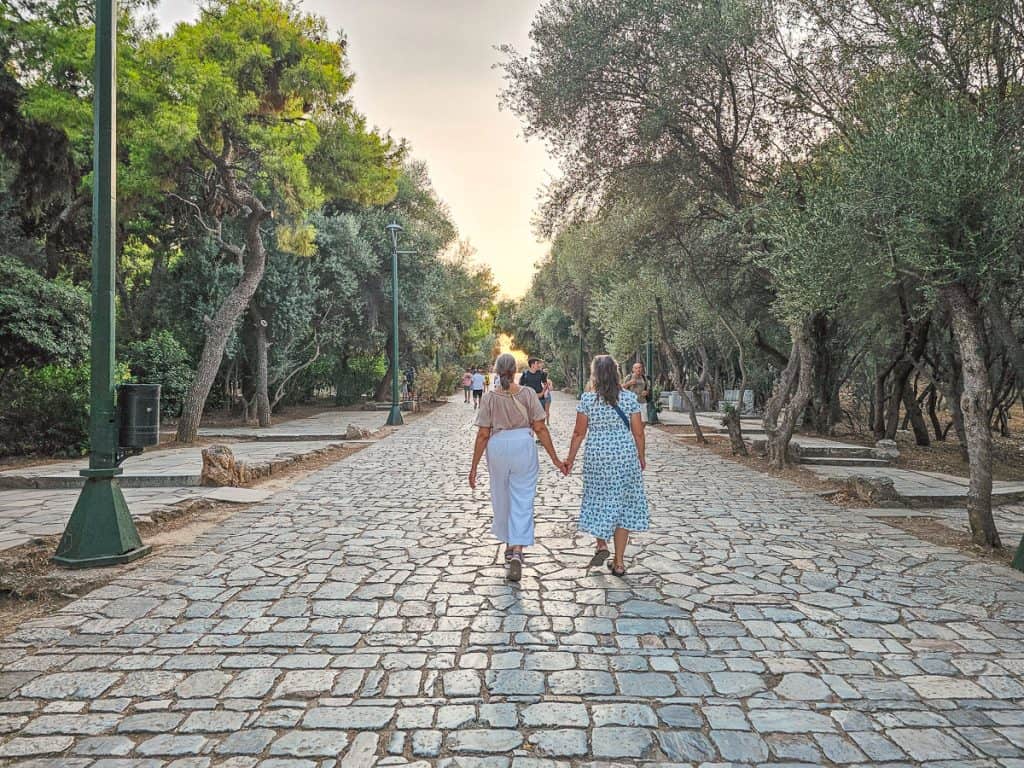
At the top of the hill is the Heroon of Mousaios monument, which you can see from the Acropolis. The “summit” of Philopappos Hill has great views, but we actually thought that the panoramic ledge about halfway up the hill was the best spot for taking pictures of the Acropolis.

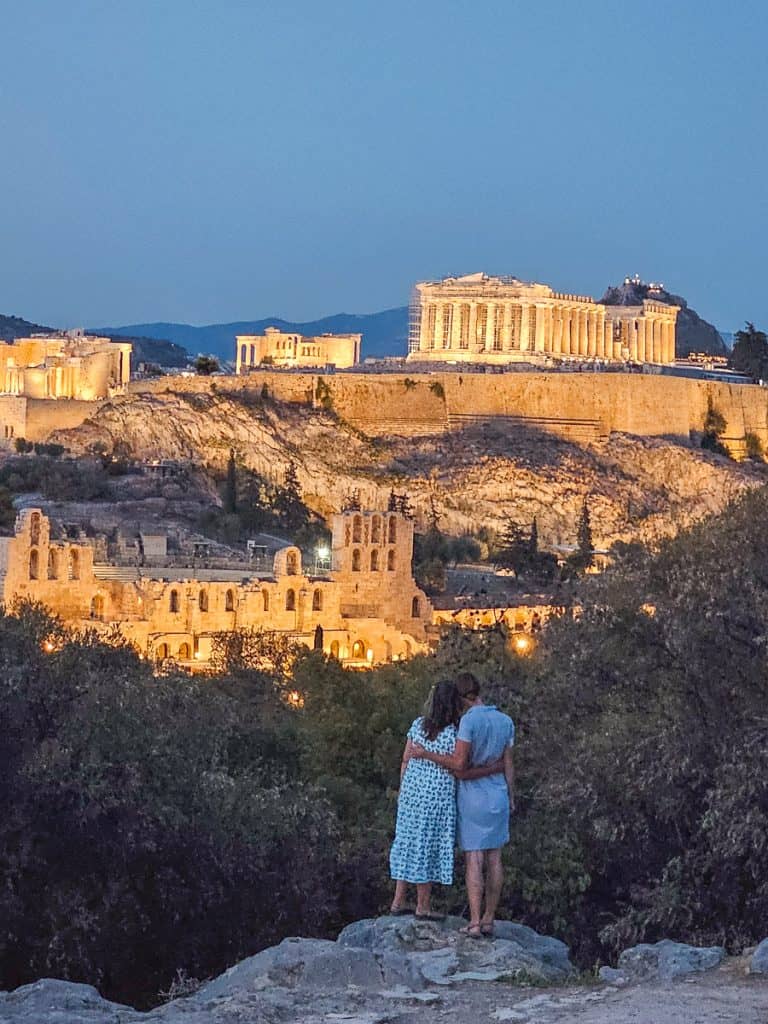
While you’re not as high up as on Mount Lycabettus, on Philopappos, you’re much closer to the Acropolis, so you can see the structures in more detail, and even see the Agora below it.
Though there were probably the same amount of people as at Mount Lycabettus, it didn’t feel crowded at all – there was tons and tons of space to spread out and enjoy your own spot and still get a great view of the sunset. Make sure you stay until the sky is dark and the Acropolis is lit up – it’s a beautiful sight!
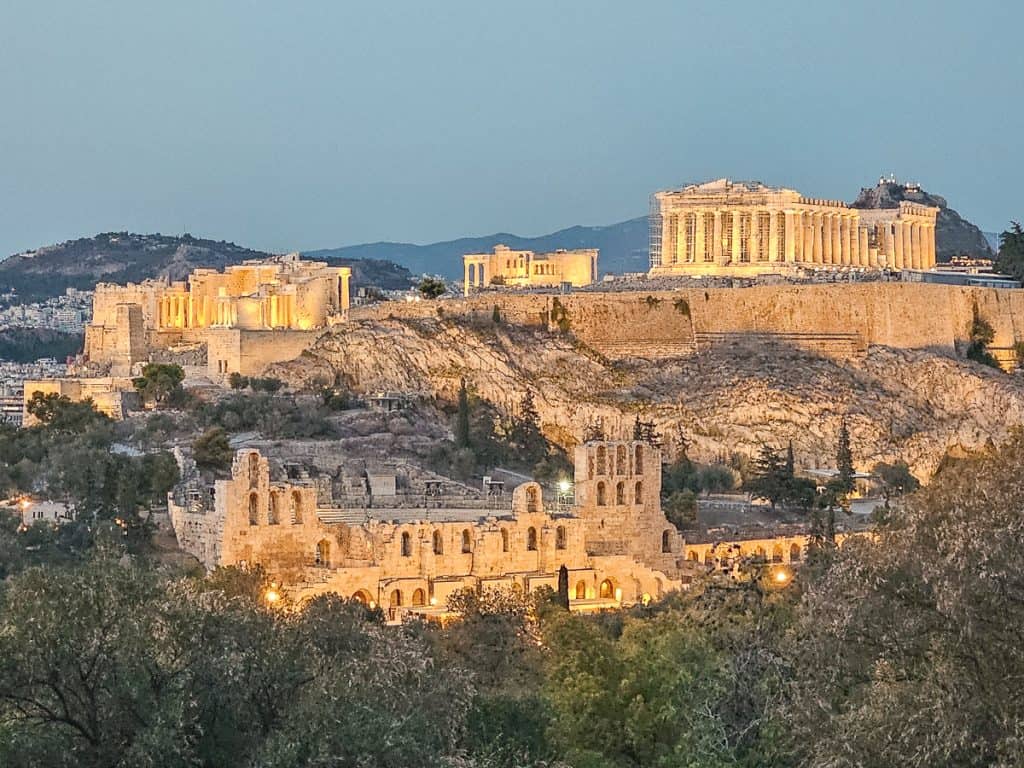
Stephanie’s Tip: If you only have one day in Athens, I’d 1000% just do Philopappos Hill, and unless you’re visiting in low season (which TBH could still be very busy—the platform is not huge at all), I’d skip Mount Lycabettus altogether.
9. Areopagus Hill (Mars Hill)

Areopagus Hill, also called Mars Hill, is a small rocky outcrop right next to the Acropolis that offers wonderful views. (Not to be confused with Philopappos Hill, which is nearby and also offers great views.)
It’s a short walk up from the Acropolis main entrance to the hill, and then you can walk around and explore. Be careful, as the rocks are craggy but also incredibly slippery. The views, though, are excellent—looking up at the Parthenon and Acropolis from one angle and down over the Ancient Agora from another.
In ancient Athens, the Areopagus was where a council of elders met to handle major legal cases, including serious crimes like murder and arson. According to mythology, this is where Ares was put on trial by the other gods for killing Poseidon’s son.
For those familiar with the Bible, this is also where Paul gave one of his sermons in Athens, as mentioned in the Book of Acts.
10. Kapnikarea Church
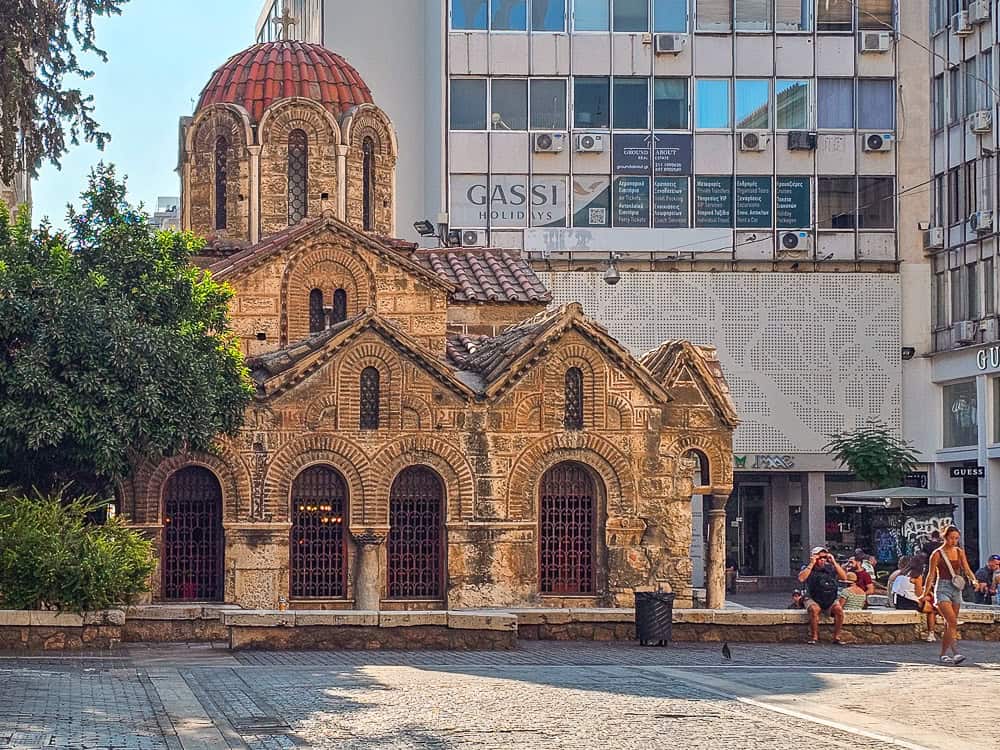
This small Greek Orthodox church sits right in the middle of a busy shopping street, which makes stumbling upon it feel kind of surreal. The structure is distinct and historic—it was built around 1052 and is one of the oldest churches in Athens.
Step inside, and you’re immediately surrounded by rich, colorful frescoes that cover the walls, arches, and ceiling.
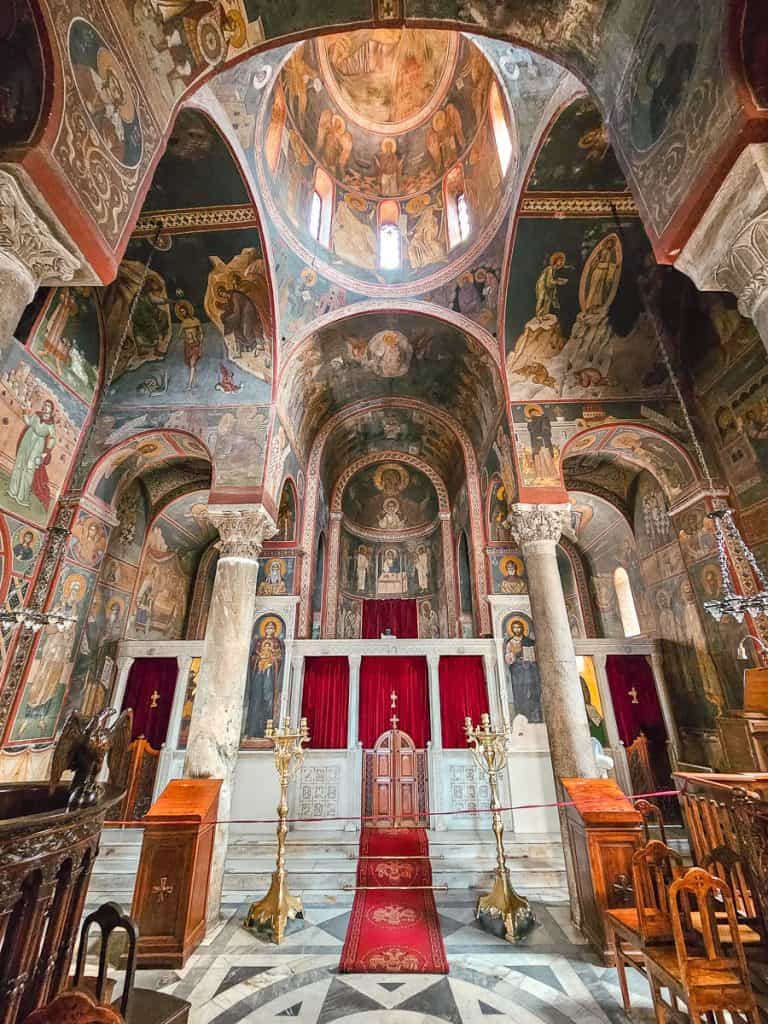
Greek Orthodox tradition doesn’t typically include statues like you’d see in Western churches. Instead, they use painted icons, and Kapnikarea is a perfect example of how beautiful that tradition can be.
The original frescos were destroyed over the years, so the current paintings are a 1940s restoration—and the artwork is absolutely stunning. We were blown away by the vibrancy and detail throughout the entire space.
11. Holy Metropolitan Church (Athens Cathedral)
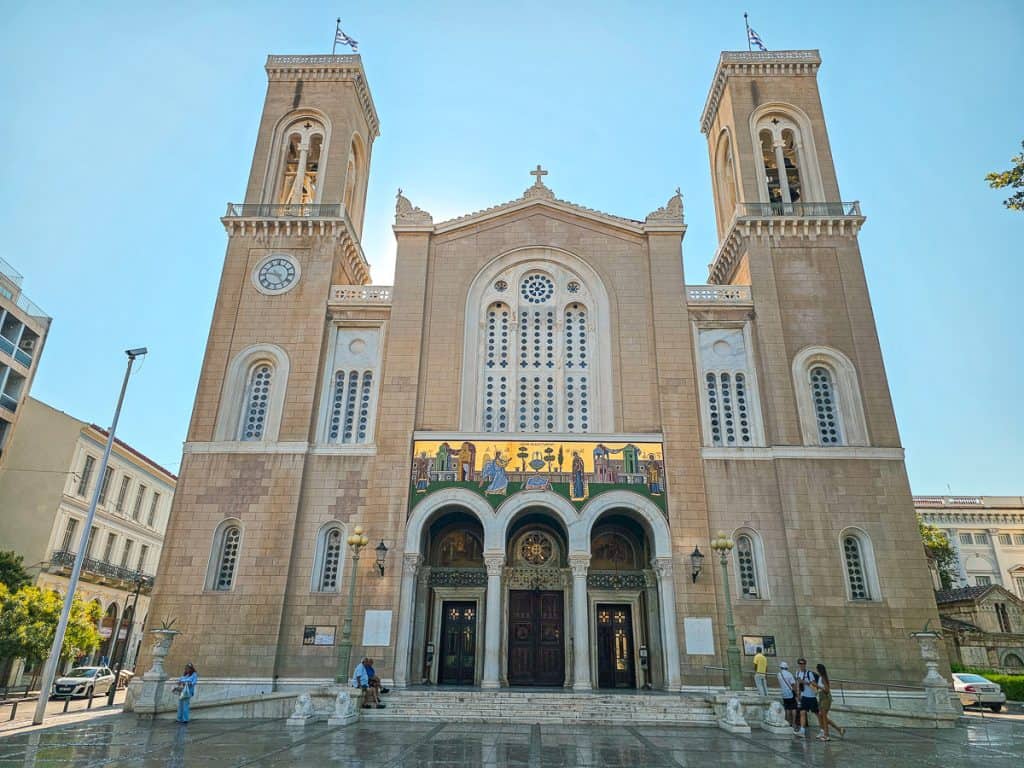
This is a stunning Greek Orthodox church with grand vaulted ceilings—much larger and more impressive than the smaller, cozier churches elsewhere in the city. It’s filled with arches, a large central dome, and colorful frescoes covering nearly every surface.
Just a couple of blocks from Kapnikarea, it’s easy to swing by, and definitely worth stepping inside to take in the scale and detail.
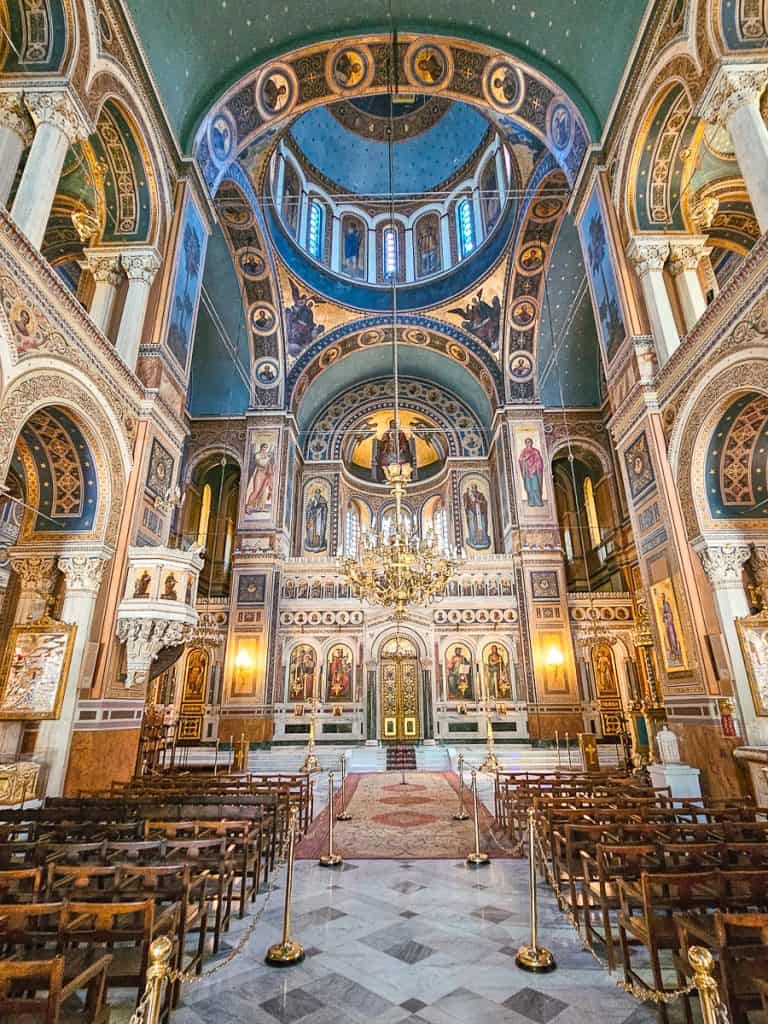
12. Plaka Neighborhood
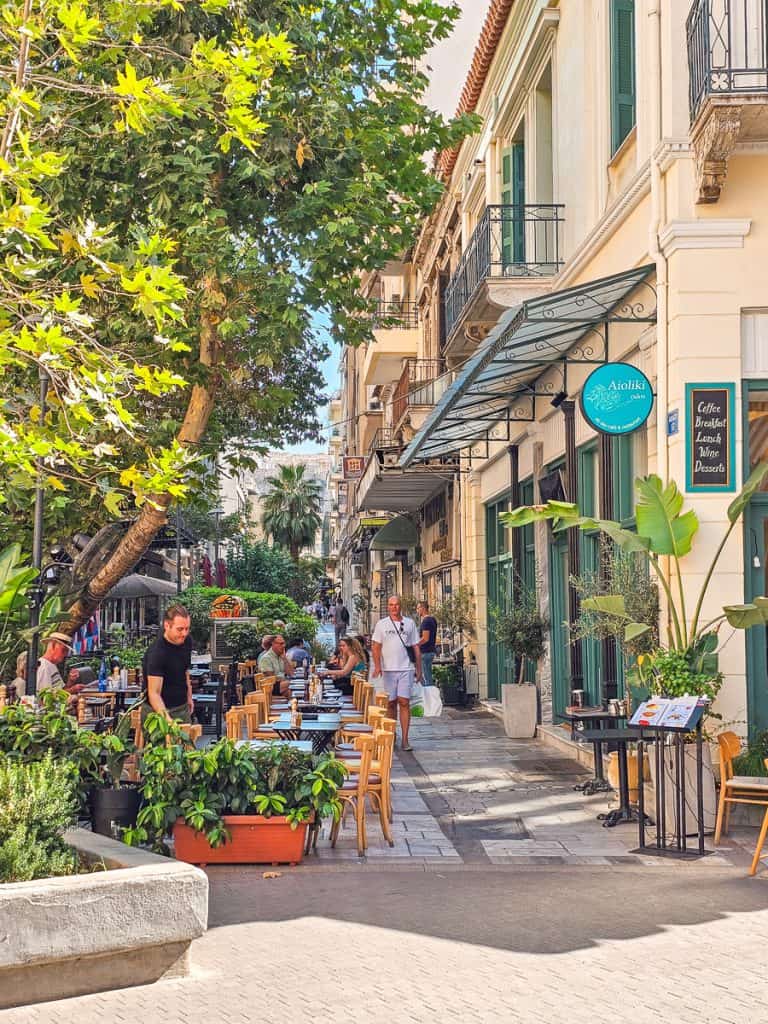
Plaka is one of the oldest neighborhoods in Athens, sitting right at the base of the Acropolis and built around the edges of the Ancient Agora. Some of the streets here actually trace back to ancient times, which is wild to think about as you’re walking through.
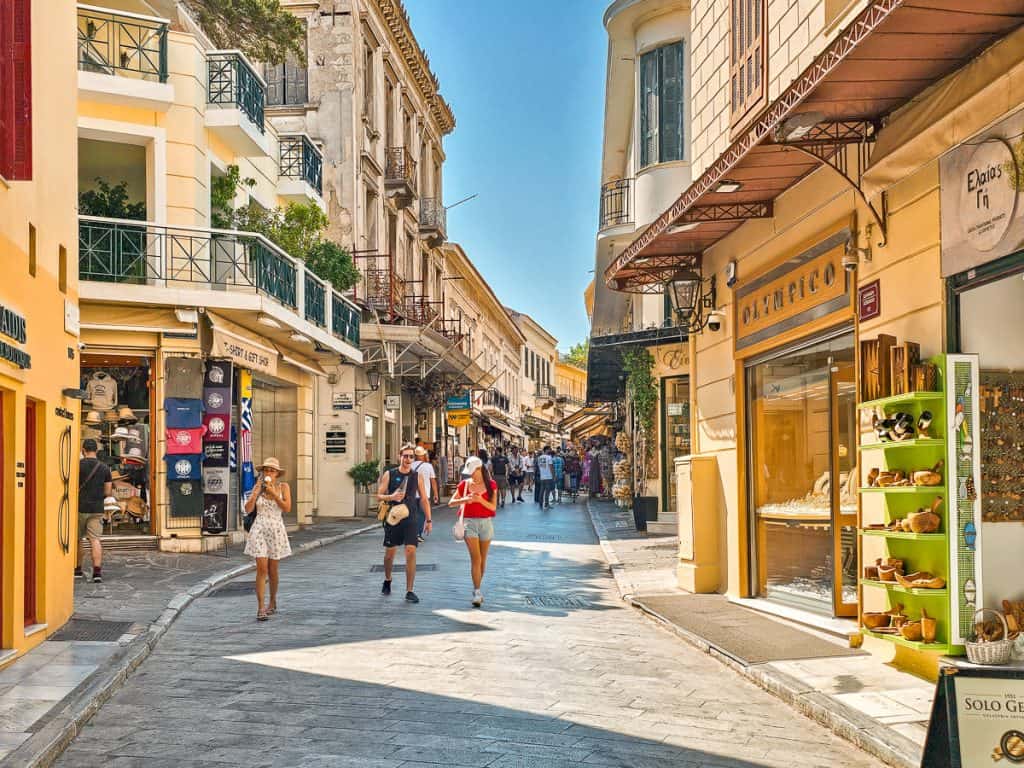
It’s a charming area to explore, with a mix of main streets and quiet little side alleys. Most of the shops lean touristy—think souvenirs and local crafts—but there are also a few more boutique-style spots mixed in. You’ll also find plenty of restaurants and cafes, many with outdoor seating and views of the surrounding ruins.
Even if you’re not in the mood to shop, it’s definitely worth a walk through.
13. Monastiriki Square

This is one of the main squares in historic Athens and a spot you’ll likely pass through more than once.
Right on the square is the small Virgin Mary Pantanassa Church, a small stone church that used to be part of a nunnery.
It’s a quick stop and you can’t go far inside, but just stepping through the entrance is nice—there are painted archways, a little dome, and clusters of hanging lamps that make it feel peaceful and a bit unexpected in the middle of all the activity.

The Tzisdarakis Mosque is also here, built during the Ottoman era and is now part of the Museum of Greek Folk Art. And you get a solid view of the Acropolis from the square, which is always a plus.
If you’re around on a Sunday, the square hosts a popular flea market that spills into the surrounding streets. It’s a fun place to poke around for antiques, vintage stuff, and souvenirs.
14. First Cemetery of Athens
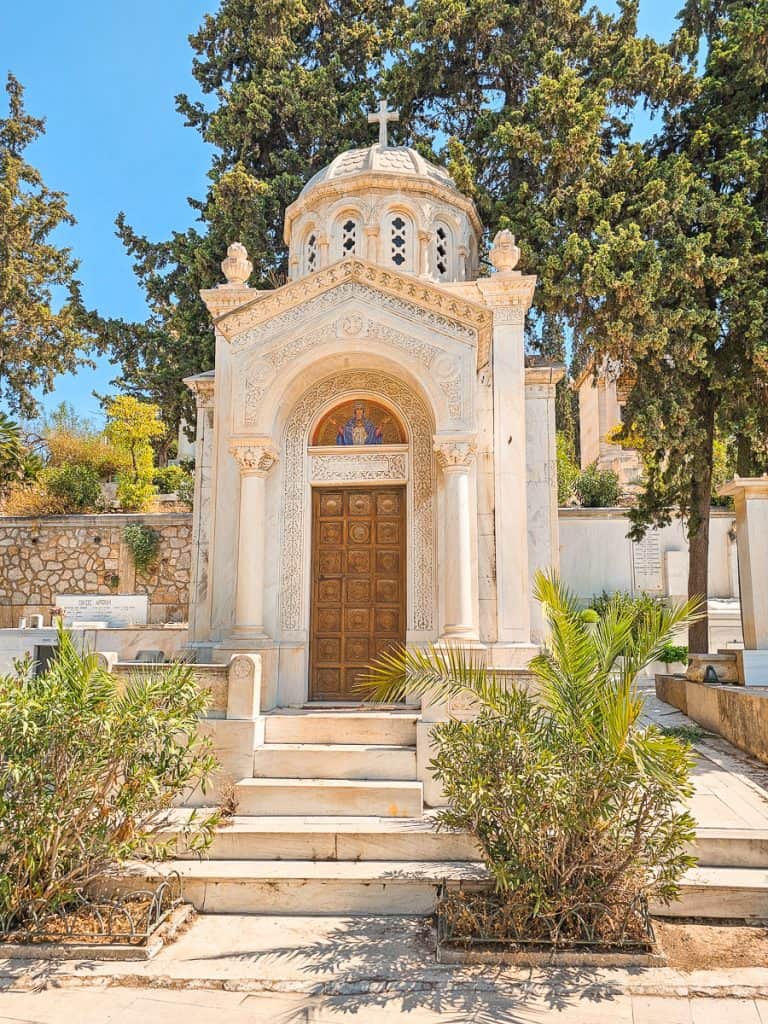
If you enjoy visiting historic cemeteries, this one is especially worth a stop. It’s the official cemetery of Athens, and it’s sprawling and grand, filled with elaborate tombs, statues, and monuments. Many well-known Greek figures—politicians, artists, actors, journalists, singers—are buried here.
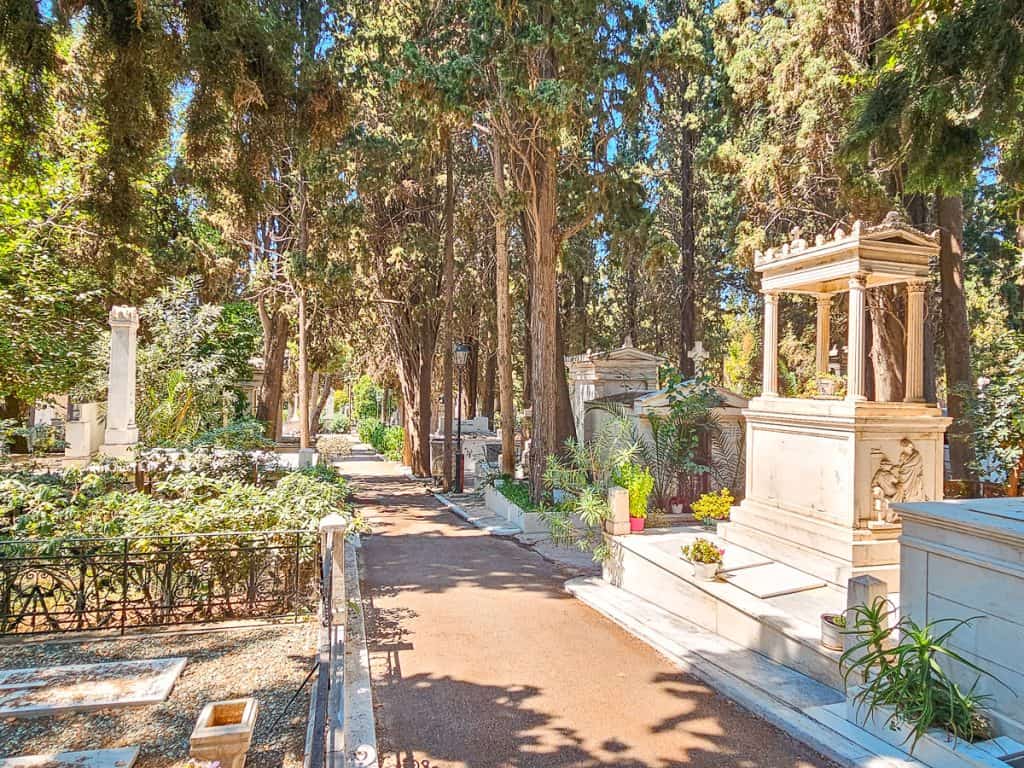
It’s free to enter, and you can just wander through the tree-lined paths, taking in the beautiful stonework and old graves. Some tombs are massive and intricately carved, and the whole space feels almost like an open-air sculpture garden. It’s peaceful, quiet, and easy to explore at your own pace.
15. Panathenaic Stadium

This is the site of the first modern Olympic Games in 1896—and the only stadium in the world built entirely of white Attic marble. It’s massive and gleaming and yet another fascinating significant historical site.
The stadium you see today was carefully reconstructed to match the 2nd-century version that once stood here, which itself was built on the site of even older athletic arenas from ancient Athens.
It’s still used for ceremonial events and even played a role in the 2004 Olympic Games. It holds up to 68,000 people, and even from the outside, it feels enormous.
You can pay to go inside and walk around the track, sit in the stands, and visit a small museum tucked under the seating. But honestly, you can get a really good sense of the scale and the site just by viewing it from the front gate.
Where to Eat in Athens
Greece has some of my favorite cuisine in the entire world, and Athens is no exception. There are a ton of great restaurants in Athens, these were two of our favorites:
Greco’s Project: On Monastiriki Square, this was one of our favorite restaurants of the trip. The tiropita (baked cheese in a flaky crust, drizzled with honey) was particularly excellent!
El Greco: Located not far from the Ancient Agora. We came for lunch, and the yogurt with fruit and honey was amazing on the hot summer day.
Getting Around Athens
Most of the sites in Athens are quite close to each other, and for the most part, you can just walk around the city. However, it’s a 40 minute walk from the National Archeological Museum in the northern part of the city to the Panathenaic Stadum in the southern part.
If you decide that a walk is too long or that you just want to get out of the heat, taking Ubers in Athens is incredibly cheap and easy.
One person in our group was having some issues with their legs, so we took a lot of Ubers and only paid €4-6 per ride around the city. We also took an Uber from the airport to our hotel in central Athens, which was €42—still not bad.
Map of Athens Attractions
The Wrap Up
Athens is an absolutely incredible city! Walking through the streets, you’ll enjoy delicous food and vibrant city life, while also feeling connect to literal millenia of history. Between the monuments, the views, and the impressive museum collections, expect an immersive experience!






